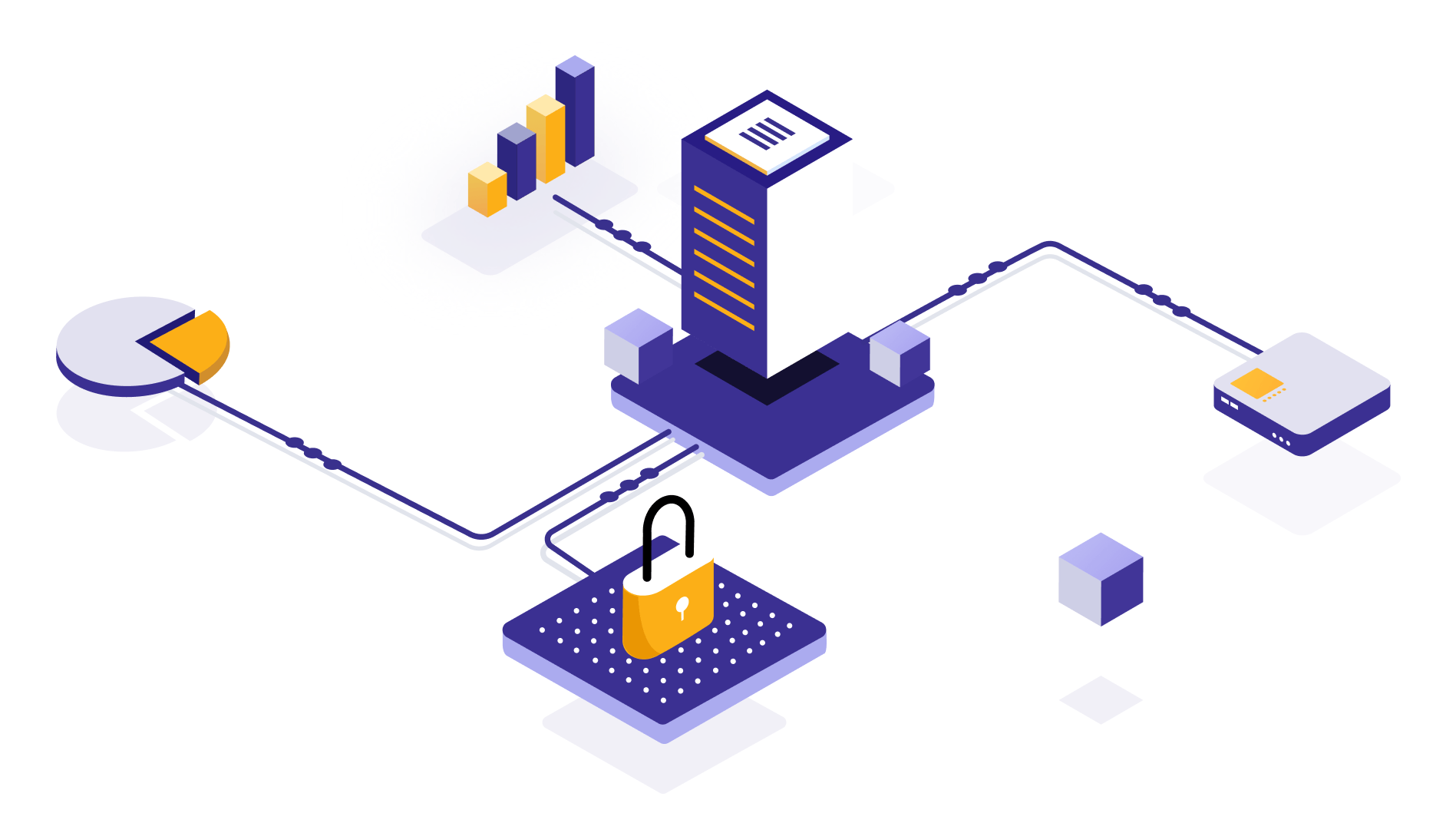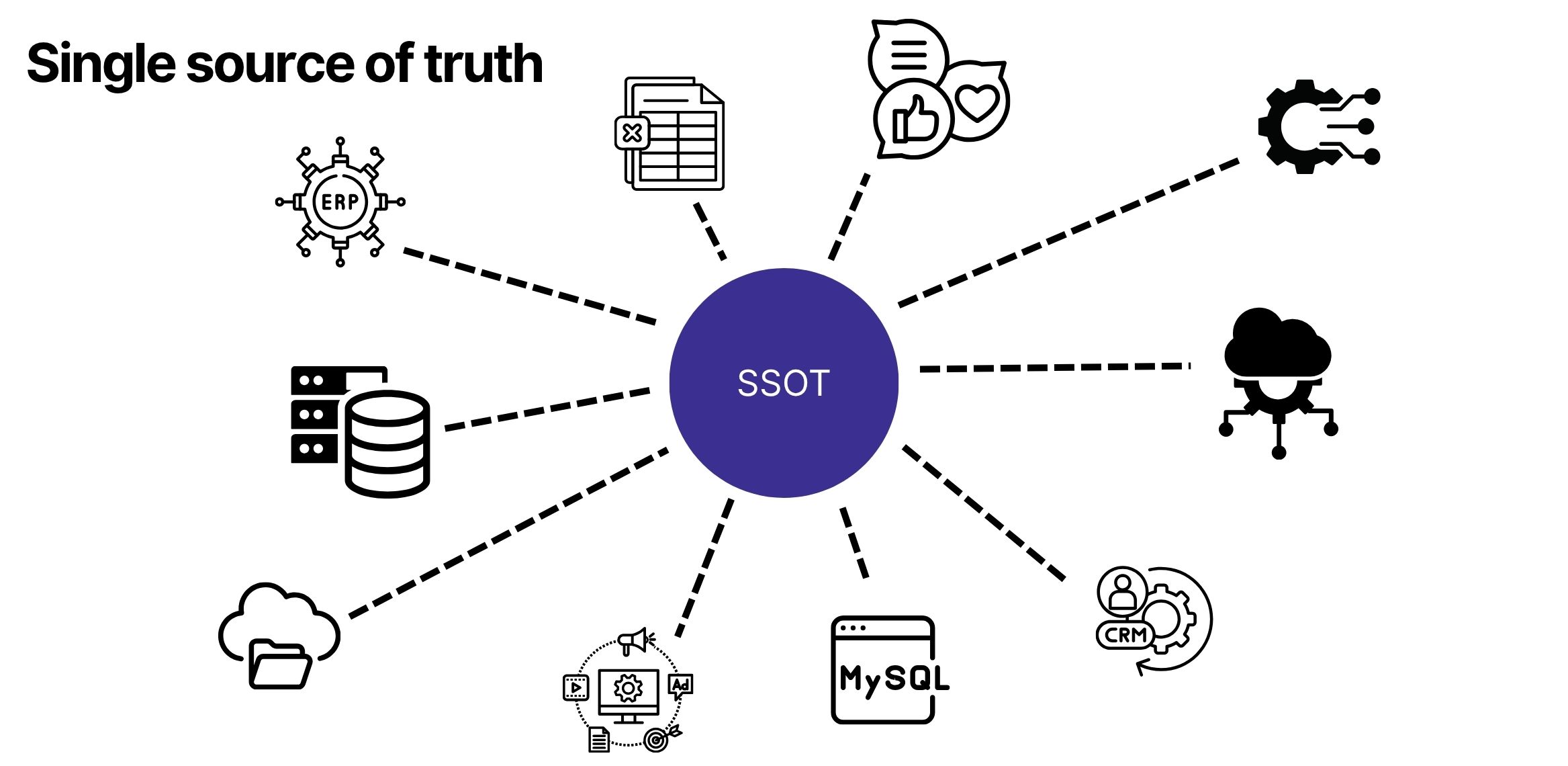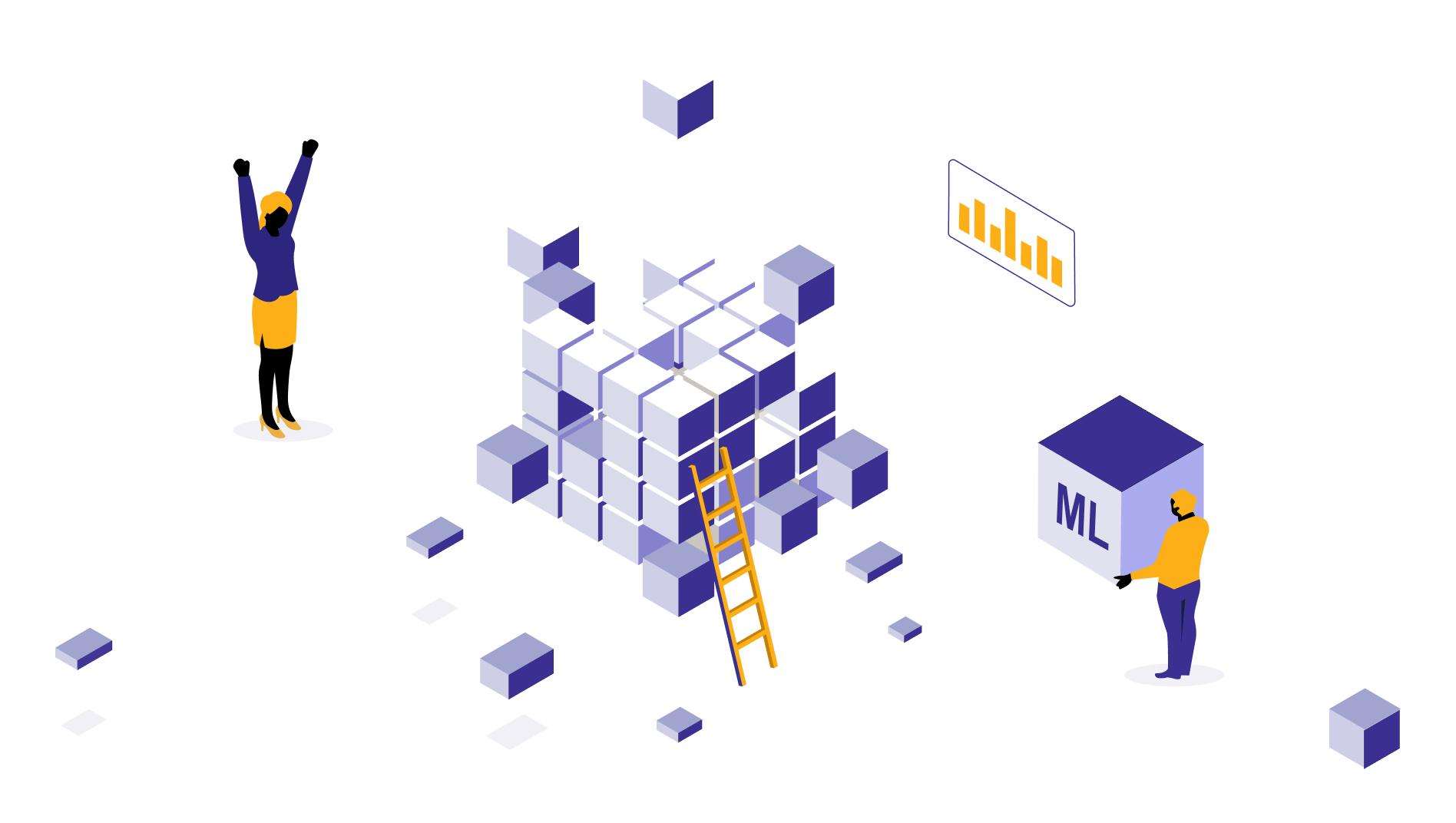A guide to single source of truth
Learn what a single source of truth is, its importance, and its benefits for businesses. What are some common forms of SSOT you might be using already? And, how you can implement SSOT despite overcoming conventional data challenges like data governance, stewardship, etc.

Subu
Nov 25, 2025 |
7 mins

The global data and analytics market is expected to grow super fast at a CAGR of 12.8% within 2030. This means that every company is ready to capitalize on its resourceful asset - its data - and is ready to make it the core of all of its digital transformation initiatives. From powering Business Intelligence to embracing AI.
But where should this all start?
Start from the ground up and set a strong data foundation. A single source of truth. Dive deep to know how a single source of truth enables you to be fully data-driven.
What is a single source of truth?
SSOT stands for Single Source of Truth. Single source of truth means a centralized hub connecting all your organization's data sources, a place where anyone within the organization can access up-to-date business information they need.
Building a single source of truth involves aggregating data from all data points and ensures quality, governance, and zero redundancy.
With every department being siloed with its separate applications and data sources, SSOT acts like a bridge connecting all of them and providing a coalesced view.
Single source of truth is important as it offers a unified and standardized view of your data together to draw inferences out of them together. - data from customer details, sales pipelines, ad campaign results, operations data, accounting and finances, and more.
Think of it as a new, scalable data architecture, which gets you across higher levels of the data analytics maturity model and not just a storage solution for your data.

How to build a single source of truth?
From a technical standpoint, there are four to five steps involved in building a single source of truth for your business.
Choosing a centralized platform to host your data like cloud, a data warehouse, or a data mart, or hybrid data systems.
Deciding the data points and sources to connect to your SSOT.
Envision what organizational goals and information your SSOT should reflect.
Maintaining and offering support to get the best out of your data and establish data democratization across teams.
Single source of truth vs. single version of truth
The difference between a single source of truth and a single version of truth is that the former is more of a master system for organizational data. Single version of truth is more of an approach where you deliver a unified number and perspective across different departments and decision-makers. Both terms are often used interchangeably.
SSOT prevents data duplicates and enables reliable storage. SVOT helps the organization move towards a centralized goal, providing uniform insights to make unanimous decisions.
Why should you need SSOT for business?
Leaders of today want collective, holistic, and actionable insights to make major decisions. With a master data management like an SSOT, they no longer get compartmentalized data that they have to piece information together.
Also, this single source of truth acts as a one-stop place, serving the right data to the right person at the right time. No one has to wait for hours, go through the IT, or be bogged down with multiple versions of information.
Meanwhile, the workload of IT and business intelligence teams would be reduced, allowing them to focus on other strategic measures.
Smooth collaboration across teams, ready-to-access business insights, and the whole organization as a connected unit - This is how a single source of truth empowers your organization.
What happens when your organization doesn’t have a single source of truth?
Five plus departments, 50+ applications, numerous employees, and customers, imagine the amount of data here as this company grows steadily. Imagine the number of times you feel overwhelmed to see various duplicate versions of files and reports. And the challenges don’t end here.
Here are the common challenges such companies face without one source of truth.
1. Siloed functions
Each department functions on its own and has its master data. So, the silos become strong barriers preventing them from working together, correlating data, and producing newer insights.
2. Data duplication
The same customer record could be present with three teams - sales, marketing, and customer service, making your insights weak and inaccurate.
3. Data sprawl
This is a condition of data overload. Here, organizations have way too much data yet they are clueless when it comes to finding a needed insight. Also, they don’t know where it’s all residing, how it gets transformed, who uses it, etc. If you want to know how to manage data quality consistently, then start with controlling data sprawl and preventing breaches thereby.
4. Clouded insights
Together, all the above bottlenecks prevent leadership from analyzing the holistic condition of a company. Or rather, the analysis happens with too much effort from all sides. Either way, the leadership team is not able to make instant and informed decisions.
Implementation of SSOT
We have worked with several clients who had data access and compliance challenges due to inconsistent and multiple sources of truth. This is the approach we followed to implement a single source of truth for them.
Data discovery
This stage is about finding and documenting all data sources and databases the company currently uses and cataloging them in the metadata inventory. By understanding your business objectives, we align the key metrics you want to measure to the hidden value behind your data.
Data integration and storage
With the help of data pipelines, we connect and integrate data from all data points to a staging zone (the bronze layer) before it’s moved to the intended transformation and storage zone.
The data reaches the silver zone then. It becomes structured here as it undergoes cleansing, standardization, and transformation. Finally comes the golden layer which is a cloud computing data warehouse or a lakehouse from where data is made available for end users.
By employing ETL pre-processing and post-processing, we ensure zero data loss as data moves through these layers.
Analytics and BI
With the help of reporting dashboards, we help business leaders get instant access to actionable insights with a few clicks.
Data governance
We ensure everything from role-based access control to data ownership to data encryption to help you stay compliant with regulatory requirements.
Learn more: Customer 360
Benefits of a single source of truth
If implemented successfully, SSOT has a lot to offer and that benefits everyone regardless of their roles.
- Smashing silos
Departmental data is no longer withheld within its territory. You also get the merged view of the data, offering a standardized perspective for everyone and bringing people closer.
- Accurate data
As you draw data from multiple sources and put them in one place, you avoid duplicates and redundancies. This leaves space only for relevant information that in turn generates accurate insights.
- Enhanced decision-making process
Accurate insights drive better and faster decisions from everyone. And it happens simply and seamlessly without someone manually compiling reports or making presentations.
- Secured access to data
With the alarming rise of cybercrimes, SSOT is how you can regulate your data storage process. It becomes much easier to implement data security and governance principles that mandate how data must be stored, who should access it, what kind of access they have, and many more.
By implementing SSOT, you will be able to comply with governance and compliance requirements.
- A new level of transparency
A company without SSOT, is already transparent, posting frequent updates of each other, sharing files upon request, and sending company news through emails. However, SSOT unlocks the next level, enabling them to be transparent without putting in the extra effort.
Everyone knows and sees what others are working on based on their authority levels. Everyone can access common business insights and come up with recommendations. Tracking touchpoints and making internal follow-ups become a breeze. A new culture of transparency begins thriving through which you can retain the best talents and make their work smoother.
- Aligns everyone toward common goals
Real growth happens when every department works in unison. With SSOT, an organization can see how each department can contribute to the common goal and set interconnected objectives. So, everyone doing what they do yet with aligned goals and achieving high productivity with the single source of truth.
Single source of truth examples
Here are some commonly used single sources of truth software and systems around us.
1. Unified customer view
Also known as a single customer view or 360-degree customer view, this system does what its name says. Unified customer view is building a single source of truth for your customer data, where you can get entire information about a customer across your company records.
For example, his basic and demographic data, his purchase history, his website behavior, his reviews and complaints, social media interactions, etc. Now, each of these data is from different sources. One might be from CRM, one from the customer support records, and some from marketing data.
Traditionally, it would require greater efforts to trace these touchpoints and provide a single view, especially when all of these happened in different instances. Duplicate data might be present too in certain records.
So, companies that want to become customer-centric and personalize their approach for each are choosing single source of truth database systems like 360-degree customer view.
When this all-inclusive information becomes accessible to different teams, they can align their strategies to get desired outcomes.
2. Search engines
Search engines like Google are in a way single source of truth. You ask them a question or type a keyword. It comes back with results that match your request in every possible way. It also highlights specific information you want to see, which is fetched from different sources.
You can also find a curated list of questions that people like you asked. So, you can compare a search engine to a single source of truth, except that the former is an SSOT on a much bigger scale.
3. ERPs
ERP single source of truth is used to document and manage the day-to-day activities of businesses from project management to finance to accounting to supply chain.
People from multiple disciplines use these applications and maintain their records. The system stores these data in a consistent and accurate form and renders up-to-date insights on operations, budgeting, and other recommendations.
Final thoughts
Is setting up a single source of truth enough to become fully data-driven? An SSOT is only the beginning. Your organization has just created a space that stores up-to-date, consistent business data, drawing them from different places. But synchronizing and aggregating data isn’t enough.
You need to move towards one source of truth and make sure everyone gets the metrics served in a language they agree and understand. This can be anything from big crucial metrics like net income, revenue, etc. to operational metrics like customer acquisition cost, inventory turnover, customer satisfaction rate, lead closure rate, feature adoption, etc.
Asking how it helps to adopt a universal data language?! Imagine a company CEO discussing with stakeholders their future strategic moves. With a single version of the truth, everyone gets a view of where their business is at and can be aligned in one direction. Even though they have data coming in from all directions, they aren’t distracted. So, they are able to discuss what needs to be done, digest what their part is, and move forward quickly to action points of each.
The starting point of all of this is a single source of information with accurate and up-to-date data.
Want to know more about data warehouse cost estimation, real-time implementation of SSOT, how it benefits different parts of an organization? Here is a detailed case study of a logistics company we worked with and simplified their complicated reporting process.
SSOT starts with strong architecture. Explore our enterprise data architecture approach.

by Subu
With over two decades of experience, Subu, aka Subramanian, is a senior solution architect who has built data warehousing solutions, led cloud migration projects, and designed scalable single sources of truth (SSOTs) for global enterprises. He brings a wealth of knowledge rooted in years of hands-on expertise while constantly updating himself on the latest technologies. Beyond architecture, he leads and mentors a large team of data engineers, ensuring every solution is both future-ready and reliable.



